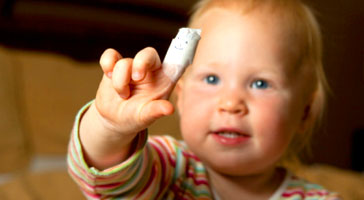 A child falls and cuts themselves on a fairly clean object. A parent takes them to the ER or Urgent Care for stitches. The staff ask if they are up-to-date on vaccines, and then PUSH hard to give a “tetanus” shot. Parent declines, and the staff threatens to call CPS or a social worker.
A child falls and cuts themselves on a fairly clean object. A parent takes them to the ER or Urgent Care for stitches. The staff ask if they are up-to-date on vaccines, and then PUSH hard to give a “tetanus” shot. Parent declines, and the staff threatens to call CPS or a social worker.
If you ever find yourself in this situation, this is what you need to know:
- Tetanus bacteria, known as Clostridium tetani, is an anaerobic bacteria, meaning it can’t survive in oxygenated environments. If the wound being treated is bleeding, or has bled, there is extremely low likelihood of tetanus infection.
- Just because you get cut on metal (rusty or not) it doesn’t automatically mean there is tetanus bacteria present. Tetanus is primarily found in soil or manure.
- Even if there was a deep puncture wound that did not bleed that was caused by an object that had tetanus bacteria on it, giving a tetanus vaccination AFTER the exposure is of no value. The vaccine is not an “instant tetanus killer”; it is well known that the tetanus vaccine takes about two weeks for the body to produce antibodies against tetanus. Giving a ‘tetanus shot’ after an injury provides no benefit.
- If there were serious concerns about tetanus exposure (a deep non bleeding wound in a farm-like environment with a lot of exposure to manure) then the ONLY thing that could help (other than allowing the wound to bleed, if possible, and cleaning the wound with soap and water or hydrogen peroxide) would be the TiG shot (tetanus immunoglobulin) which is an anti-toxin, not a vaccine. If you agree to a TiG shot, be sure to examine the box or vial BEFORE they inject it – nurses have been known to ‘mistakenly’ give the DTaP but tell you they are giving TiG.
- There is no ‘tetanus only’ vaccine available in the United States. When you are offered a ‘tetanus shot’ in an ER or by the doctor, they will usually administer the DTaP (or TDaP for those over 10 years), a 3 in 1 cocktail vaccine consisting of Diphtheria, Tetanus & Pertussis (whooping cough) bacteria, and significant amounts of aluminum (from 0.33 mg to 0.625 mg of aluminum depending on the brand). You may be told “this is a tetanus shot” but most ER facilities only have stock of the 3 in one vaccine. For a complete list of ingredients in these vaccines, see the CDC pink book list.
As a strategy to support your right to refuse this shot, I highly recommend the following actions:
- Ask for (demand) the complete vaccine package insert for the DTaP/TDaP. Point out the ingredients, especially the aluminum. Point out the multiple adverse reactions that could potentially happen to your child if they inject this vaccine.
- Point out that neither the nurse, doctor, nor hospital can be held liable should any adverse event happen as a result of receiving the vaccine they are pushing.
- Ask for the contact information of the supervisor for each person pushing you to give this vaccine. Make a note of this information.
- Ask to speak to the patient liaison representative of the facility, or the supervisor on duty. Alternatively, phone your legal advisor.[1]
- File a complaint against all staff pushing the vaccine and seeking to involve social services. Bullying of parents needs to be noted so that it can be stopped.
- Use your cell phone to record all conversations.
This situation is happening every single day. I have personally learned about many children who experience significant vaccine injury from being pushed to accept the DTap in an ER. Even one shot can cause a serious reaction.
Doctors should know this information, but often they don’t. Please don’t let their ignorance of tetanus push you to agree to a completely ineffective and potentially harmful strategy for your child.
If a medical establishment is threatening to call, or does call CPS, removal of your child is not a fait accompli – you need to remain diplomatic and factual. Don’t be condescending or superior. The role of every CPS case worker is to investigate all complaints. In the face of a calm, rational parent, they have no reason to remove your child from your care. While it is understandable that any parent facing the threat of child removal may feel threatened and become angry, you will be much better protection for your child by restraining your strong emotions.
Battling to protect our children can be extremely challenging. Facing up to the giant medical establishment is a daunting proposition. Don’t blow it by losing your cool. In your mind, imagine yourself as a calm attorney rationally presenting your case. You can’t lose because the facts and the science are on your side. However, if you become a raging emotional basket case, they will use that against you to push even harder to take your child away.
Author: Becky Hastings, wife, mother, grandmother, passionate follower of Jesus and truth. As a breastfeeding counsellor for over 23 years Becky is devoted to helping parents make wise decisions for the long-term health and wellbeing of their babies. As a member of a Vaccine Safety Education Coalition, Becky writes and speaks on the topic of vaccine safety.
[1] “I say the best protection is a preexisting relationship with a friendly attorney. While at the hospital, call the attorney immediately on the first sign of trouble. When the social worker starts the bully routine, the first thing to say is that your attorney is already aware of the situation. If the social worker just wants to “interview” you, tell him or her that you’d love to answer their questions, but they should go through the proper legal channels, I.e. they should make the request for the interview through your attorney. If they are making immediate threats or issuing ultimatums, what to do depends on state law and the particular circumstances. In all cases when bringing a child to the hospital, bring a voice recording device in your pocket or purse and have it recording as soon as you get there. There are now free apps for this purpose available for your smart phone. This is the best and least intrusive way to document medical bullying.” Thomas M.

